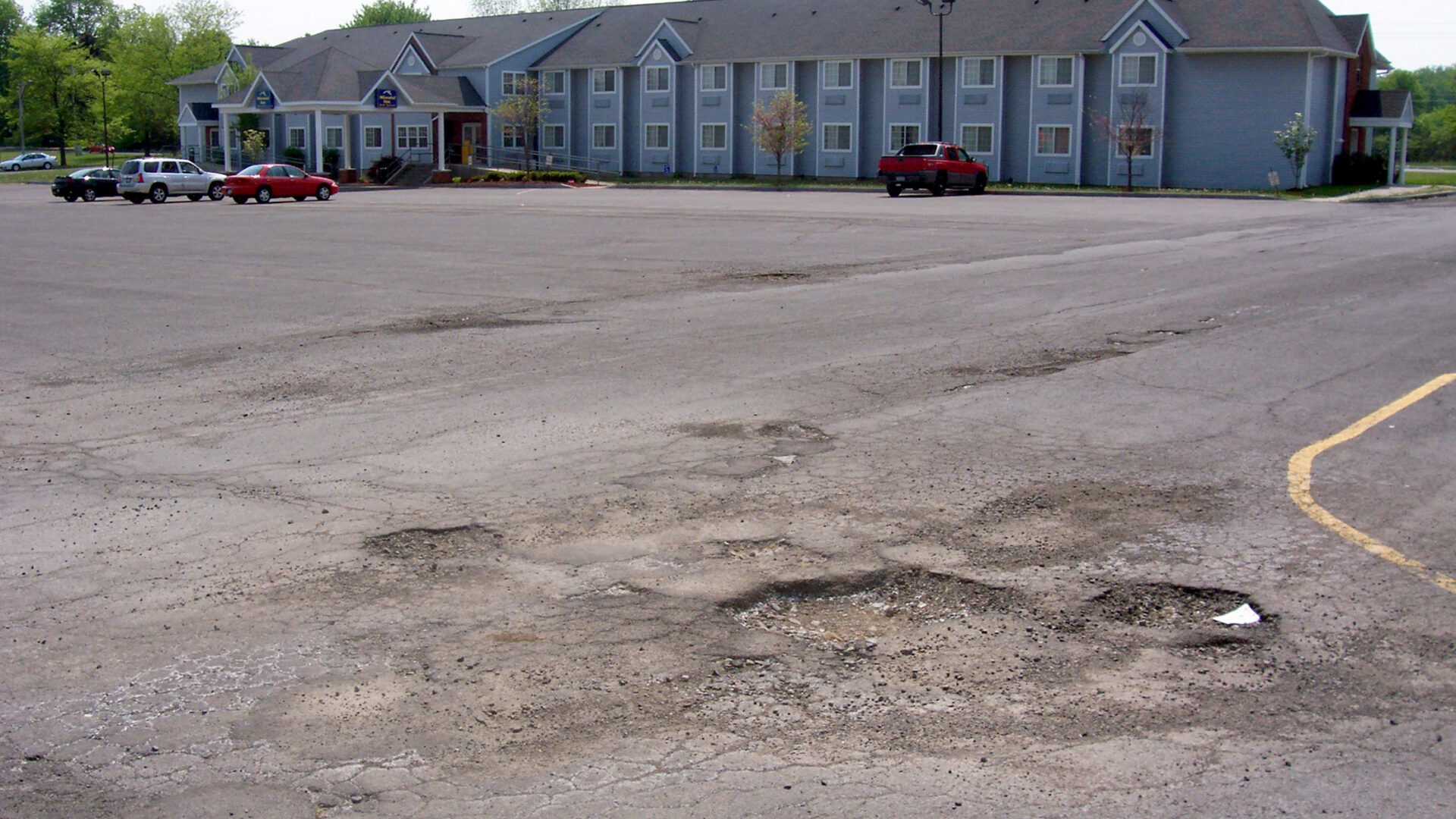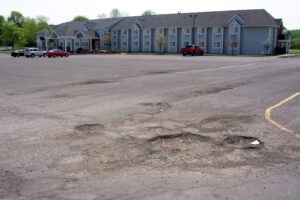The information below from our commercial paving experts here at Ruston Paving will explore the intricate process of pothole formation. We'll uncover the various factors at play and explore effective solutions for pothole prevention and pothole repair. Whether you're contending with a maze of potholes or aiming to fortify your parking lot against future damage, knowledge is the first step towards a smoother, safer surface.
What are Potholes?
Potholes, those annoying craters that seem to appear out of nowhere on roads and parking lots, are more than just surface-level nuisances. They are a result of complex processes beneath the pavement's asphalt layer surface. Potholes are essentially pavement cracks, depressions, or holes in the surface of a road or parking lot.
Characteristics of Potholes
These depressions can vary in size, ranging from small divots to large craters that pose significant hazards to vehicles and pedestrians alike. Often, potholes start as minor imperfections on the road surface, such as cracks or small divots, but they can quickly worsen if left unaddressed.
Impact of Potholes in Parking Lots
In parking lots, potholes are particularly problematic, as they not only compromise the aesthetics of the area but also pose safety risks for customers and employees navigating the lot. From causing damage to vehicles to creating tripping hazards for pedestrians, potholes can lead to costly liabilities for business owners if not properly addressed.
Factors Contributing to Pothole Formation
Potholes don't just appear overnight; they develop over time due to a combination of various factors. Understanding these factors is crucial for parking lot owners looking to prevent potholes and maintain the integrity of their pavement structure.
Weather Conditions
Weather plays a significant role in pothole formation. Rainwater can infiltrate asphalt cracks and crevices in the pavement, weakening the underlying layers and causing them to deteriorate. Additionally, freeze-thaw cycles can exacerbate this process. When water trapped in existing pavements freezes, it expands, creating pressure that further damages the pavement. As temperatures rise and the ice melts, voids are left behind, leading to the collapse of the pavement and the formation of potholes.
Poor Drainage Systems
Inadequate drainage systems can exacerbate the effects of water infiltration on pavement. If water is not properly directed away from the surface, it can accumulate and seep into the pavement layers, weakening them over time. Standing water also increases the likelihood of freeze-thaw cycles, accelerating pavement deterioration and pothole formation.
Traffic Load and Frequency
The volume and weight of traffic passing over a parking lot can contribute to potholes forming. Heavy vehicles, such as trucks and buses, exert greater pressure on the pavement, causing it to deform and degrade more rapidly. Similarly, frequent traffic can exacerbate tiny cracks and imperfections, accelerating the development of potholes.
Quality of Pavement Materials
The quality of the materials used in pavement construction plays a significant role in its durability and resistance to pothole formation. Low-quality materials are more prone to cracking and degradation, especially when exposed to harsh weather conditions and heavy traffic. Investing in high-quality pavement materials can help prolong the lifespan of the parking lot surface and reduce the risk of pothole formation.
The Process of Pothole Formation
Pothole formation is a gradual process that occurs over time as a result of various factors, including weather conditions, traffic load, and pavement quality. Understanding the step-by-step process of pothole formation can help parking lot owners identify potential areas of weakness and implement proactive measures to prevent their occurrence.
Initial Pavement Distress
Pothole formation often begins with minor surface distress, such as cracks, fissures, or surface abrasions. These imperfections may seem insignificant at first, but they can provide entry points for water infiltration and debris accumulation.
Infiltration of Water into Pavement Layers
Rainwater, snowmelt, and other forms of precipitation can seep into the pavement through cracks and crevices. Once infiltrated, water can penetrate the underlying layers of the pavement, weakening its structural integrity and compromising its stability.
Expansion and Contraction Due to Temperature Changes
As temperatures fluctuate, water trapped within the pavement expands and contracts. During freezing temperatures, water freezes and expands, exerting pressure on the surrounding pavement materials. When temperatures rise, the ice melts, leaving behind voids and gaps within the pavement layers.
Erosion of Pavement Materials
Repeated cycles of freezing and thawing, coupled with the pressure exerted by traffic loads, can cause erosion of the pavement materials. This erosion weakens the pavement, making it more susceptible to deformation and collapse.
Development of Voids Beneath the Surface
As pavement materials erode and water infiltrates the layers beneath the surface, voids and gaps begin to form. These voids compromise the structural integrity of the pavement, creating unstable areas that are prone to collapse.
Final Collapse and Pothole Formation
Eventually, the combined effects of water infiltration, temperature changes, and traffic load lead to the final collapse of the pavement surface, resulting in the formation of a pothole. Once formed, potholes can quickly worsen if left unaddressed, posing safety hazards and increasing the risk of damage to vehicles and pedestrians.
Impact of Potholes on Parking Lots
Potholes aren't just unsightly; they can have significant implications for the safety, functionality, and overall appeal of parking lots. Understanding the impact of potholes is crucial for parking lot owners to prioritize repairing potholes.
Safety Hazards for Vehicles and Pedestrians
Potholes pose safety risks for both vehicles and pedestrians navigating the parking lot. For vehicles, hitting a pothole can cause damage to tires, wheels, and suspension systems, leading to costly repairs for drivers and potential liability issues for parking lot owners. Pedestrians are also at risk of tripping and falling in potholes, especially if they are obscured by water or debris.
Damage to Vehicles
Potholes can cause significant damage to vehicles, particularly if they are large or deep. Hitting a pothole at high speeds can result in tire blowouts, bent rims, and misalignments, requiring expensive repairs and inconveniencing drivers. In severe cases, potholes can even cause accidents or collisions, further increasing the risk of injury and property damage.
Aesthetics and Property Value
Potholes detract from the overall aesthetics of the parking lot, giving the impression of neglect and poor maintenance. Unsightly potholes can deter customers and tenants from frequenting the property, leading to decreased foot traffic and revenue for businesses. Additionally, potholes can lower the property value of the parking lot and surrounding area, making it less desirable for potential buyers or tenants.
Increased Maintenance Costs
Addressing potholes can be costly and time-consuming for parking lot owners. In addition to repairing the potholes themselves, owners may need to address underlying drainage issues, pavement deterioration, and other related problems to prevent future pothole formation. Failing to address potholes promptly can lead to more extensive damage and higher repair costs in the long run.
Solutions for Pothole Prevention and Repair
Preventing potholes and addressing existing ones requires a proactive approach that addresses the underlying causes of pavement deterioration. Parking lot owners can implement a variety of strategies to mitigate the risk of potholes and maintain the integrity of their surfaces.
Regular Maintenance and Inspection Routines
Establishing regular preventive maintenance and inspection routines is crucial for identifying potential issues early and addressing them before they escalate into potholes. This includes regularly inspecting the parking lot for cracks, potholes, and other signs of pavement distress, as well as promptly repairing any damage that is identified.
Proper Drainage Systems
Ensuring proper drainage systems are in place can help prevent water from pooling on the surface of the parking lot and infiltrating the pavement layers. This includes installing adequate drainage channels, gutters, and catch basins to direct water away from the surface and prevent it from seeping into the pavement.
Quality Pavement Materials and Construction Techniques
Investing in high-quality pavement materials and employing proper construction techniques can help prolong the lifespan of the parking lot surface and reduce the risk of pothole formation. This includes using durable materials that are resistant to weathering and traffic loads, as well as ensuring proper compaction and sealing of the pavement layers during construction.
Soil Stabilization Techniques
Soil stabilization techniques, such as those offered by Ruston Paving, can help improve the strength and stability of the underlying soil, reducing the risk of pavement deformation and pothole formation. This may involve introducing stabilizing agents into the soil or incorporating reinforcement materials to enhance its load-bearing capacity.
Full Parking Lot Services
Enlisting the services of a reputable parking lot maintenance company, such as Ruston Paving, can provide comprehensive solutions for pothole prevention and repair. From routine maintenance and inspections to specialized soil stabilization techniques, we can help parking lot owners maintain a safe, functional, and aesthetically pleasing surface for their customers and tenants.
Contact the Commercial Paving Experts at Ruston Today
Don't let potholes ruin the appearance and safety of your parking lot any longer. Take proactive steps to prevent pothole formation and ensure the longevity of your commercial parking lot's pavement by partnering with Ruston Paving. Our team of pothole repair experts offers comprehensive solutions, including soil stabilization techniques and full parking lot services, tailored to meet your business' needs.
Contact us today to schedule a consultation and take the first step towards a smoother, safer, and more resilient parking lot surface by calling us or filling out the form below to get started.



